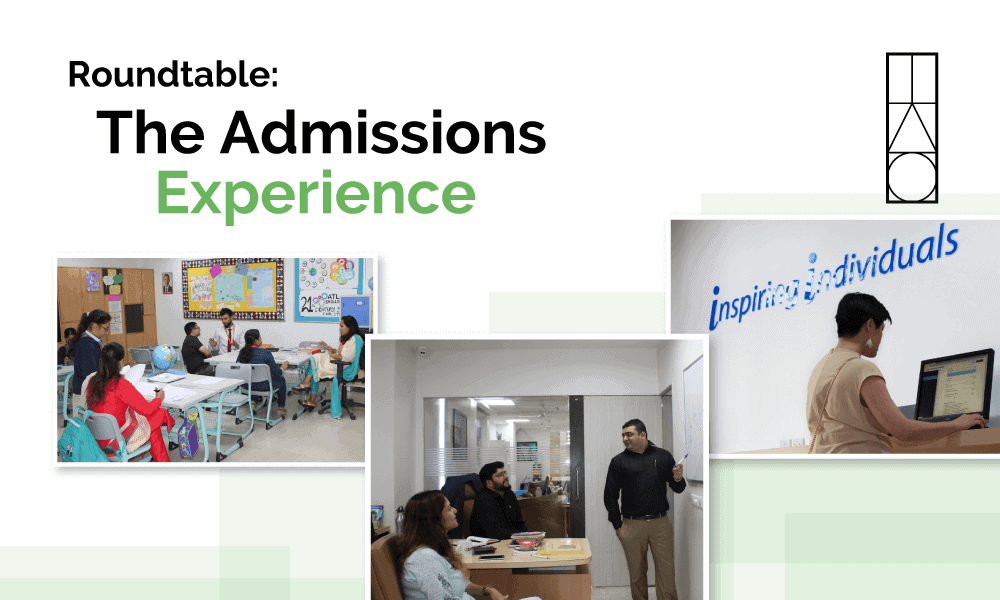The admissions experience can vary widely from school to school. Each school might cater to different demographics, need to abide by different school policies, and ensure they are compatible with local culture and expectations. The IAB recently caught up with four schools from around the world to find out more about how they create a great admissions experience for every prospective family.
How much does your school cater to the children in the family during the admissions process?
IB: We are a selective school so the children are completely involved in the admissions process. Once a parent decides to admit their child in the school, all children from Grade 1 to 12 have to go through a written assessment followed by an interview with the Principal/ Coordinator. Being an IB School, It is important to gauge a student’s potential and provide feedback to the facilitators so that a personalized learning plan can be created. It is also essential to determine if a child has any special needs and whether as a school, we are ready to meet the needs of that child.
LB: We like to meet all of our applicants, either online or in person, so we involve the children during the school tour, assessment and orientation. When children join during the school tour we usually leave it up to the child as to how much they want to be involved with the process. We have had occasions when the children have been completely in charge, and other occasions where the children have left all the talking to the parents. We don’t want to force them to engage during this process as they may be shy, overwhelmed or jetlagged and we prefer their school visit to be a positive experience. We have a play area in the admissions office for children who are not interested in joining the conversations. All applicants will do an assessment, and for primary school students this includes a classroom sit in. It allows the child to meet some future friends and to experience some time in the KIS classroom. It also allows us to evaluate how the child behaves in the classroom and gives the opportunity to teachers to give feedback about the student.
SF: We recently surveyed our parents on this area, and the results were very much as we suspected – their children play a crucial part in the decision making around schooling, and whilst this is particularly prevalent at upper school level, it is also the case for younger children. We support our prospective families as they involve their children via, for example, our recently relaunched admissions ambassador scheme providing peer to peer support and an emphasis in all of our digital activities in reaching children as well as parents. We’ve got further to go in this journey in 2019!
ISP: At ISP, we work with the goal that the admissions process is a high touch experience which implicates the whole family, in a manner which is appropriate and desirable for the individual. Sometimes circumstances necessitate that a child is not included because they may not be aware of the move, or there may be a concern about the child’s placement at the school. As well, families relocating from abroad may not be able to visit the school all together, and so it may be harder to cater to the child’s interests if they are not on the tour or part of the initial admissions visit. Ideally, for older children (Middle + High) we offer the possibility of a half day or full day buddy day experience (if they so choose) and offer that the family follow and share our Instagram feed to get a sense of the student experience and life at the school. During the admissions process, there is an applicant questionnaire which seeks to get to know the child’s interests, any potential fears or misgivings about changing schools and people/places/ things that may be important to them. The answers on this questionnaire influence our well being support structures, initial homeroom/classroom placements and, in many cases, follow up information about extra curricular activities and meet up groups!
What technology (if any) do you use in your admissions journey for families? How does technology either detract from or enhance the admissions journey?
IB: Technology is an integral part of the admissions journey right from spreading awareness about the school through social media to the final leg of the admissions process. We use Chat Bots and Facebook Messenger to answer initial parent inquiries, and online forms to capture the inquiry and submit the application. A virtual school tour and Youtube videos have been helpful in providing a glimpse into the school for prospective parents who are unable to visit the school in person. WhatsApp has been used to communicate with parents; informing them of important events and providing visual evidence after events. Technology is the most effective tool an admissions officer can use to enhance the parent journey. However it still lacks the human ability to cater to individual needs. School selection is a parent’s most important decision. Technology should be used to only enhance the parent experience, but it can never replace the human touch.
LB: We use an online application portal which is hugely helpful to the admissions staff and slightly tedious for applying families, especially if they don’t speak English or are not very computer savvy. The initial form gives us some valuable information about the family so we can make sure we focus on the right things during the tour. In a way, technology acts as an initial filter. Only families who are serious about getting more information about the school would make the effort to complete the form. At KIS, we are also not able to accommodate families who do not have any English speakers. We provide a prospectus which is accessible in print, on our website, and can also be viewed in an app that uses Augmented Reality to showcase more of the school through videos, photo galleries and infographics. They can also enjoy a 360 degree online virtual tour, which includes both photos as well as 360 degree video. Once families visit the school we don’t use technology much during the visit, though we will show the use of technology in the classroom.
SF: Having previously worked in a very technology driven student recruitment and admissions process at University level, I’ve enjoyed the more balanced and bespoke service we offer personally at TASIS England. However, this does not mean that technology doesn’t have a part to play, and we could helpfully look to other industries to understand the marrying of personalisation and automation. From simple and efficient online application processes to virtual tours, the right level of technological inputs have a role to play, and particularly for the many families who are unable to visit us owing to distance from home.
ISP: We currently do not use any specific technology during our admissions meetings and visits, beyond large TV screen slideshows which are part of the welcome waiting areas. We do cater our individual responses to families to include links to multimedia, student work and our active social media pages, which we think serve to provide an additional lens into the daily life at the school.
In October 2018, we moved to a completely paperless admissions process via OpenApply, and this has been overwhelmingly positive from a parent perspective as they can engage with the platform on their own time, we can send internal/external notes which keeps them all linked to the applicant, and there is a facilitated review process across campuses and admissions committee members. There have been some expected hiccups and new workarounds along the way, but we find this provides an enhanced admissions journey, both for the family as well as the admissions team!
How important do you believe it is to conduct wider training of the faculty in working with the admissions team and what does your school do to ensure that the admissions team is fully supported?
IB: The admissions and marketing team is responsible for identifying a school’s key messages and delivering them through all possible channels, and one of the strongest channels to spread them is through facilitators. Marketing should begin internally so that the entire school speaks the same language as this is essential to help spread the word of mouth. At Edify, we identify some important facilitators like Coordinators, HODs etc. who understand their programmes well and can be an influencing factor in parent decision making. These facilitators meet the parents as well as answer their academic queries. Simultaneously, we create opportunities for admissions staff to attend important teacher training, classroom observations and academic meetings to experience academic life first hand and stay updated with all the happenings on a regular basis.
LB: It is important for the faculty to understand the school well and to know how the school is being presented by the admissions department, but this shouldn’t be a surprise, as the school should be who it says it is and do what it says it does. However, providing some background information regarding the admissions process, expectations of the staff, and the challenges the team faces will certainly help with the process. Every year during a PD day our department gets the chance to talk to the entire faculty and we share our expectations with them. This is more enlightening for the staff than you think it would be. For example, something as simple as “when we are visiting your classroom it would be great if you could say hello to the visitors” was deemed a helpful comment, as some teachers didn’t know if they should pretend we’re not there or actually say hello. I would recommend that every marketing and admissions team asks for an opportunity to address the faculty so that everyone understands how the admission process works and what they can do to help.
SF: I think it’s absolutely essential that the admissions and marketing departments spend time explaining their work to faculty, and actively engage in partnership working with all staff at their schools, whether they are faculty, administrative or technical/service staff – everyone is part of the buyer’s journey. Indeed, at TASIS England we regularly receive comments around the friendly effectiveness of our security staff, and the ease with which parents can meet with senior administrators and our Head of School, Bryan Nixon, during their tours illustrating how such a wide range of colleagues outside the admissions office can make a real difference. Our school recognises the need for a whole school approach and promotes this dialogue on a formal and informal basis.
ISP: We believe it is essential that the admissions team and faculty are partners in promoting our school learning environment and culture. There are changes and new elements on an on going basis and our capacity to correctly frame and inform prospective families is intrinsically linked to the quality and frequency of information sharing amongst our colleagues. It’s for this reason that we find lunchtimes, casual chats or after hours social situations actually hugely important vehicles to share what we do and how we do it.
There is always room for improvement in this area, as people may not inherently understand the processes, trends and ‘pulse’ an admissions office can and does provide. This year we are implementing a dedicated training time for both new and returning faculty members to be able to focus on facilitating that exchange, providing details regarding our strategic action plan for the upcoming school year and generally answer questions about our processes.
What do you believe is key in making the admissions journey a positive one for families?
IB: There are multiple elements that we have to keep in mind to ensure a positive experience for visiting families.
Hospitality – the entire school is responsible for admissions. If a parent is greeted well, right from security to the receptionist, offered tea/coffee, made to sit in a comfortable environment, half the job is complete. If we are trying to sell a Rolls Royce, remember the experience we provide to the parent has to be on par with the brand.
Going an additional mile – if we go an additional mile to help parents, the entire experience reaches the next level. We have multiple families that have relocated from other countries. We’ve provided them with assistance to scout a flat in nearby localities by giving them the contact number of the broker and even driving them down to the nearby location to see a flat.
Do not try to sell – the admissions team needs to have the intent to spread the school’s key messages among the parent community instead of trying to sell the admissions. The focus should be purely on spreading positive word of mouth about the school. BE A STORY TELLER, NOT A SELLER!
LB: I believe that the admissions team has to be personal and friendly, and they should know the school very well. Questions should be answered quickly and truthfully, and the admissions team has to be able to listen well. Procedures should be clear and should be followed.
SF: Ultimately, families need consistent information and answers throughout their journey, delivered quickly and with an empathetic smile, from first enquiry to enrolment – and from everyone they meet in their journey to school, from agent or relocation consultant to our admissions staff to our academic faculty and within. Our role is to equip all of those helping families with the knowledge to provide this information, and to support their children in flourishing at our school after they’ve made their informed decision to choose TASIS England for their education.
Like many international schools, many of our families have the added complexity of moving themselves and/or their children as part of the admissions process, and we pride ourselves on having a range of knowledge around every aspect of moving to our global community in Surrey. And what we do in the admissions journey – transition support, our buddy family scheme and much more – is replicated on and post arrival at the school so our families have a genuinely positive experience. Which we’re pleased that they, in turn, recommend to others, and enable our school to thrive.
ISP: It may sound simple but we believe authentic connections, efficient processes and an open line of communication is key to allowing families to be partners along the journey for information into a school. Ultimately, the more a family is adequately supported in their research and decision making process, and the more timely and honestly informed as to what the school does/does not provide, the more likely a smooth and positive transition experience, whether they apply to ISP, or elsewhere.
















 All Services
All Services


